

CHENNAI: Karnataka and Gujarat are the states making the most progress in overall preparedness and commitment in the transition to clean energy while Tamil Nadu lags, a new joint report from the Institute for Energy Economics and Financial Analysis (IEEFA) and Ember showed.
The report released on Monday analysed 16 states, which together account for 90% of the country’s annual power requirement, across four dimensions and found that Rajasthan and Tamil Nadu have started their clean electricity transition, but progress has not been consistent across all the dimensions.
The dimensions track a state’s preparedness to shift away from fossil-fuel-based power, its ability to incentivise greener market participation, its power system's reliability and its policies pushing for power sector decarbonisation. Based on this analysis, the report authors devised the States’ Electricity Transition (SET) scoring system, which measures the performance of the different states in the transition to clean electricity.
The report said that Karnataka is the only state that scored well across all the dimensions of clean electricity transition identified in this study. Gujarat was a little behind Karnataka in terms of decarbonising its electricity sector. Similarly, Haryana and Punjab have shown promising preparations and implementations for electricity transition in their respective states.
“Even the long-considered front-runners of adding renewable energy capacity, Rajasthan and Tamil Nadu, have to improve the readiness of their power ecosystems for a clean electricity transition,” says co-author Aditya Lolla, Senior Electricity Policy Analyst, Ember.
“State energy departments also need to strengthen electricity infrastructure for better integration of renewables. In addition to managing the demand and supply of electricity, ensuring effective utilisation, monitoring, and tracking of electrons is also very important,” he adds.
Tamil Nadu’s slow deployment of feeder segregation and lack of political commitment to move away from coal-based thermal power plants has pushed the state downwards in the rankings. Tamil Nadu has about 5.7 Gigawatt of new coal capacity under construction and 4 GW in the pre-construction stages.
India’s revised Nationally Determined Contribution (NDC) targets have put the country on the right path for transitioning its electricity sector, said the report’s co-author Vibhuti Garg, Director, South Asia, IEEFA. “To achieve those targets, the centre now needs the cooperation of the states to move faster in their clean electricity transitions,” she says.
The report outlines focus areas for states to improve their preparedness for transition, such as exploiting wind and solar generation potential and deploying more energy storage solutions, such as batteries and pumped hydro, for better renewable energy integration.
Visit news.dtnext.in to explore our interactive epaper!
Download the DT Next app for more exciting features!
Click here for iOS
Click here for Android